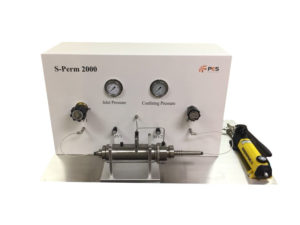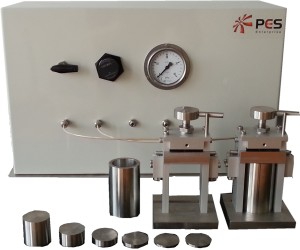S-Perm 2000 Ultra Low Permeability Analyzer
1. Overview
Ultra-low permeability refers to rock formations whose permeability is typically less than 0.1 millidarcy (mD) — and often in the nanodarcy (nD) range — where fluid flow through the pore system is extremely restricted.
Such formations include tight sandstones, shale oil/gas reservoirs, and unconventional carbonates, in which nanometer-scale pore throats and complex pore networks dominate fluid transport behavior.
The study of ultra-low permeability systems is crucial for understanding fluid storage, flow mechanisms, and production potential in unconventional reservoirs, as well as for evaluating CO₂ injection, storage, and migration behavior under reservoir conditions.
2. Geological and Petrophysical Characteristics
-
Pore Structure:
Dominated by nanopores (2–200 nm), microfractures, and organic matter-hosted pores.
Pore systems are often poorly connected, leading to high capillary pressures and strong confinement effects. -
Matrix Permeability:
Ranges from 10⁻⁶ mD to 0.1 mD, with significant anisotropy between horizontal and vertical flow directions. -
Porosity:
Generally low (3–10%), and a large proportion of pore volume exists in closed or semi-closed systems, accessible only through diffusion or pressure-driven desorption. -
Flow Mechanisms:
Conventional Darcy flow transitions to slippage flow, Knudsen diffusion, and adsorbed-phase diffusion as pore size decreases below ~100 nm.
3. Laboratory Evaluation
Ultra-low permeability measurements require specialized instruments and procedures to achieve reliable data under controlled stress and temperature conditions.
Typical testing methods include:
-
Steady-State Flow Method:
Measures gas or liquid permeability under constant flow conditions using high-sensitivity differential pressure transducers. Suitable for high-accuracy determination at nD–μD levels. -
Pulse Decay Method:
Commonly applied to tight rocks; a small pressure pulse is introduced at one end of the core, and the transient pressure decay is recorded to calculate permeability. -
Full-Diameter or Whole-Core Method:
Used for evaluating large-diameter or fractured samples, integrating both matrix and fracture permeability to capture representative behavior. -
Triaxial Stress Control:
Confining and pore pressures are applied up to 70–100 MPa to simulate in-situ stress conditions and to observe stress sensitivity effects on permeability. -
Temperature-Dependent Measurement:
Tests conducted from ambient to 200 °C help assess the influence of thermal expansion, fluid viscosity, and phase transitions on flow properties.
4. Factors Affecting Permeability
-
Effective stress and pore compression (mechanical deformation).
-
Clay content and water saturation (swelling and pore blocking).
-
Organic matter and kerogen maturity (pore development).
-
Fracture density and orientation (dominant flow paths).
-
Fluid type (gas slippage and CO₂ adsorption/desorption effects).
5. Engineering and EOR Implications
-
In ultra-low permeability reservoirs, natural energy drive is weak, and hydraulic fracturing or CO₂ injection is necessary to enhance flow.
-
CO₂ flooding or CO₂ huff-and-puff can effectively reduce oil viscosity and promote miscibility, improving recovery in tight systems.
-
Nanoparticle, surfactant, and low-salinity water EOR techniques are often combined with gas injection to improve sweep efficiency.
-
Understanding ultra-low permeability behavior is also critical for CCUS projects, as it governs CO₂ containment and migration within the storage formation.
6. Summary
Ultra-low permeability reservoirs represent the frontier of unconventional resource development.
Their complex pore structures, non-Darcy flow behavior, and strong stress-sensitivity require advanced laboratory systems, such as steady-state micro-flow testers, whole-core permeability instruments, and high-pressure visualization cells, to accurately characterize.
Accurate measurement and modeling of ultra-low permeability are essential for optimizing production strategies, CO₂-EOR efficiency, and long-term carbon storage safety.
S-Pore 200 Matrix Permeameter and Porosimeter
1. Overview
Matrix permeability and porosity are fundamental petrophysical parameters that define a rock’s ability to store and transmit fluids within its pore network.
They describe the storage capacity (porosity) and flow capacity (permeability) of the rock matrix, which together control hydrocarbon production, CO₂ injectivity, and enhanced oil recovery (EOR) efficiency.
In tight and ultra-low permeability reservoirs, such as shales, tight sandstones, and low-permeability carbonates, matrix permeability and porosity are often extremely low and highly sensitive to stress, temperature, and fluid saturation.
2. Matrix Porosity
Porosity (ϕ) is the fraction of the bulk rock volume that is occupied by pore spaces.
It reflects the fluid storage capacity of the rock and can be classified as:
-
Primary porosity: formed during sediment deposition (intergranular, intercrystalline).
-
Secondary porosity: developed after diagenesis (fractures, dissolution, vugs).
Porosity is determined through helium expansion, mercury intrusion, or imaging methods (CT or SEM).
For reservoir engineering, effective porosity—which represents the interconnected pore volume contributing to fluid flow—is most relevant.
Typical values:
-
Conventional sandstone: 10–30%
-
Carbonate: 5–25%
-
Tight/shale reservoir: <10%, often 2–6%
Porosity decreases with increasing depth, compaction, and cementation, and can vary anisotropically between vertical and horizontal directions.
3. Matrix Permeability
Permeability (k) quantifies the rock’s ability to transmit fluids through interconnected pores under a pressure gradient.
It depends on pore throat size, connectivity, tortuosity, and fluid type.
Matrix permeability represents the intrinsic flow capacity of the rock framework, excluding fractures or large-scale discontinuities.
In tight reservoirs, permeability can be so low (10⁻⁶–0.1 mD) that non-Darcy effects, such as gas slippage and Knudsen diffusion, become significant.
Measurement Methods
-
Steady-state flow method: applying Darcy’s law for gas or liquid flow under constant rate.
-
Pulse-decay method: analyzing transient pressure decay for ultra-low permeability samples.
-
Stress-dependent measurement: observing permeability changes with confining pressure to determine stress sensitivity and formation damage potential.
| Reservoir Type | Matrix Permeability (mD) | Flow Regime |
|---|---|---|
| Conventional sandstone | 10–1000 | Darcy flow |
| Tight sandstone | 0.01–1 | Transitional |
| Shale / ultra-tight | 10⁻⁶–0.01 | Non-Darcy / diffusive |
4. Relationship and Significance
Porosity and permeability are closely related but not linearly correlated.
High porosity does not necessarily imply high permeability—especially in tight or cemented formations where pores are poorly connected.
Together, they determine:
-
Reservoir quality (RQI, FZI) and productivity index
-
Fluid saturation and relative permeability behavior
-
CO₂ storage capacity and injectivity potential
-
EOR response to surfactant, polymer, or gas injection
Accurate determination of these parameters enables better reservoir simulation calibration and production forecasting.
5. Applications
-
Evaluation of reservoir quality and heterogeneity
-
Design and optimization of EOR and CO₂ flooding schemes
-
Assessment of stress sensitivity and fracture-matrix contribution
-
Reservoir simulation input for dynamic modeling
-
Core-scale calibration for digital rock or well-log interpretation
6. Summary
Matrix permeability and porosity are key indicators of reservoir storage and flow performance.
Their accurate measurement under simulated reservoir conditions provides the foundation for understanding fluid transport behavior, EOR efficiency, and CO₂ sequestration potential in both conventional and unconventional formations.
In ultra-low permeability systems, specialized instruments—such as steady-state micro-flow permeameters and helium porosimeters—are essential for obtaining reproducible and meaningful data.

